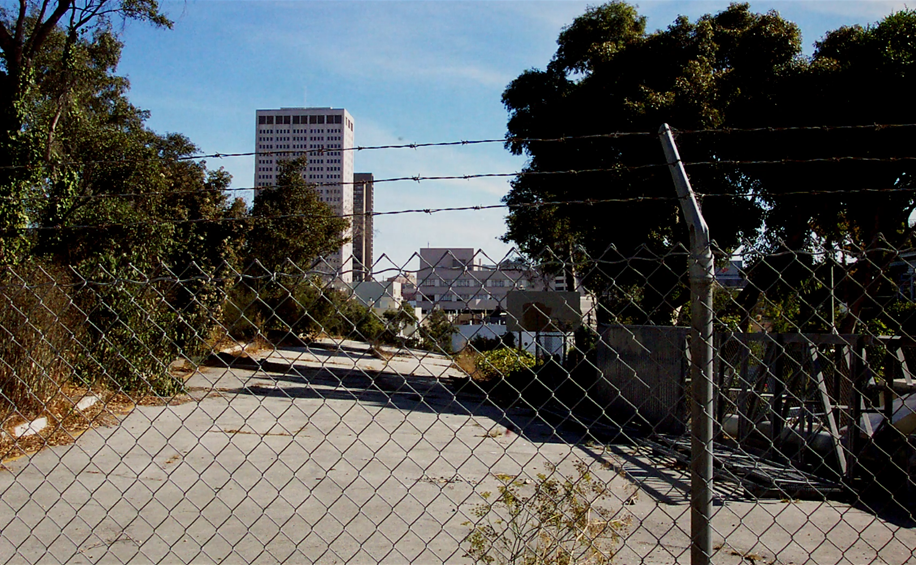While land acknowledgements at events in Australia and Canada can often sound pro forma, they serve an important symbolic function. They remind everyone that the land upon which these events are held belonged to someone else and was often stolen.
Land acknowledgements can open up uncomfortable conversations about dispossession and genocide without extracting emotional labor from Indigenous people. These conversations are urgently needed in the United States. Most U.S. voters don’t understand why.
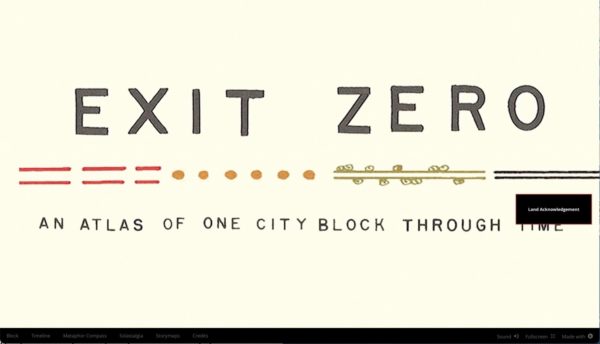
Screengrab of launch page to “Exit Zero” with Land Acknowledgement box layered over the word “time.”
Unpacking “Woke Indoctrination”
With his recent election as Speaker of the House of Representatives in the U.S. Congress, Kevin McCarthy announced that issues he finds urgent include “woke indoctrination” in education. His acceptance speech following 14 failed votes was published on YouTube by Forbes under the title “McCarthy Rips ‘Woke Indoctrination’, Open Borders, Inflation In First Speaker Speech.”
Forbes Media is best known for its financial magazine and lists of billionaires. Much like other news media in the United States, it pushes the myth of the American Dream as wealth through smart investment and unearned income — not through hard work.
The term American Dream was conceived in the 1930s in more democratic terms of shared opportunity and achievement. Until the civil rights struggles of the 1960s, however, many U.S. citizens were excluded.
But popular culture expressions change meaning over time.
The term “woke” initially referred to someone who was educated about history and committed to social justice. Rightwing media and talk radio appropriated the term and redefined it as an existential threat to white people. The term is now a racist dog-whistle in the same category of as “gangs of rapists” flooding over the southern border.
It appears that “woke indoctrination” was added to McCarthy’s speech as part of concessions to fringe white nationalists in the Republican Party. These white nationalists support the former president, deny the 2020 election results, and do not condemn the January 6th insurrection.
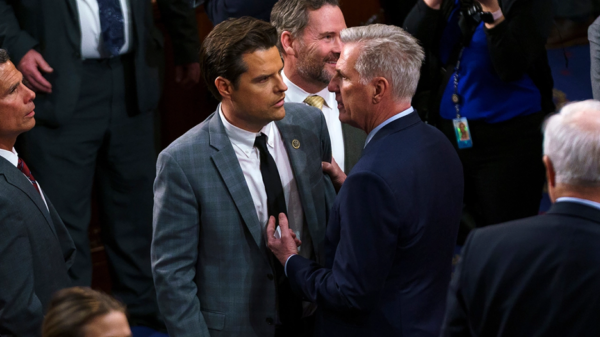
Florida Republican Representative Matt Gaetz speaks with California Republican Representative Kevin McCarthy as the House votes to adjourn following the fourteenth ballot for Speaker on Friday, January 6, 2023. Source: The Hill.
Normalized by Forbes, the racist dog-whistle is also an attack on U.S. education, historically under-funded precisely because it makes voters more difficult to manipulate.
It is possible to be patriotic without being nationalistic. Patriotism in the United States, however, requires acknowledgement of past violence and lies that the Republican Party believes are facts — or, perhaps, “alternative facts,” in Kellyanne Conway’s rebranding of state propaganda.
But patriotism does not need to follow the Democratic Party’s whitewashed version of U.S. history, emphasizing the greatness of the idea of “America” to overcome its violent past without committing to reparations. It casts the United States as exceptional. The Republican Party laces U.S. exceptionalism with xenophobia and nationalism, bordering on neofascism.
Whether championed by either party, U.S. national exceptionalism is a naïve belief that the United States is inherently good, something difficult to swallow for anyone who has witnessed other countries or perhaps their own devastated by U.S.-backed dictators, free-trade policies, or military invasions.
It is also increasingly difficult for U.S. citizens to believe. Many voters oppose both the Democratic Party’s free-trade policies and to the Republican Party’s white nationalism. This patriotism through questioning and protesting has roots in the 1930s — and also the broad coalitions that challenged the World Trade Organization’s policies at its 1999 meeting in Seattle.

Mass protests of 40,000 environmentalist, students, union workers, and other citizens against the WTO. Seattle Municipal Archives, November 29 1999. Source: OpenDemocracy.
Part of this linguistic confusion over education as “indoctrination” results from the defunding of public education at all levels in the United States combined with the corporatization of news media. Land acknowledgments initiates uncomfortable conversations, not only about reparations, but also about education.
Documentary, Augmented Reality, and Land Acknowledgement
Documentary is a media form premised on education. The term’s etymological roots reside in the Latin word docere, meaning to teach.
Many people find documentary film and television boring because of its pedagogical function. At the same time, character-driven documentaries continue to make gains on cable television and streaming platforms — and even in theaters. These feature-length documentaries adopt Hollywood conventions of exceptional individual protagonists with clearly defined conflicts to overcome.
A recent example of this approach is “In Her Hands” (USA, 2022), a film about Zarifa Ghafari, considered the youngest woman mayor in Afghanistan. The film follows her career before and after the U.S. withdrawal of military forces and its return of the Taliban. Executive produced by Hilary and Chelsea Clinton, the film is streaming on Netflix and is anticipated to garner an Oscar nomination, a huge red flag when the documentary chronicles people who are neither White nor Western.
In contrast, independent documentary makers foreground more complex structures. Many projects have moved to interactive forms that are intuitive to use and can provide new documentary architectures to explore complexity.
As I’ve argued before in writing about interactive documentaries in the United States and Palestine/Israel, invisible geographies and inaudible histories need to be made present. Interactive documentaries mobilize these geographies and histories by augmenting reality with layers of information. This type of documentary operates as a form of land acknowledgement. It makes legible dispossessions and genocides imbedded in the histories of settler colonialism.
Interactive documentaries push documentary way beyond the character-driven feature-length documentaries. These documentaries explore the people who have lived in particular places over the centuries but who have been excluded from U.S. education beyond the superficial gestures.
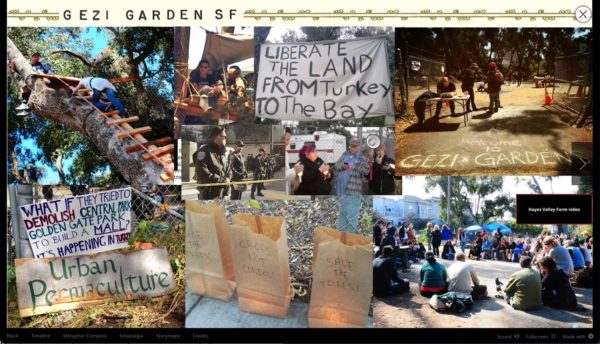
Screen grab of collage of protest images in “Exit Zero.”
S. Topiary Landberg’s “Exit Zero: An Atlas of One City Block through Time” (2022) is a web-based interactive documentary about a single city block in central San Francisco and the site of multiple, dramatic transformations during the nearly 250-year history of the United States. As the documentary begins, the words “land acknowledgement” stop over the word “time” in the tagline “an atlas of one city block through time.”

Screen grab from “Exit Zero” of hyper-gentrification without land acknowledgment.
Once in the heart of a vibrant multi-ethnic Victorian neighborhood, the block was transformed into a freeway exit, subsequently damaged by earthquake. It then became an interim-use community garden. Today, it is the site of a green-living apartment complex.

Screen grab from “Exit Zero” of hyper-gentrification without land acknowledgment.
As a synecdoche of the dynamics of hyper-gentrification which translates as eviction of working-class and migrant communities that defines San Francisco today, “Exit Zero” invites its audience to get tangled in a web of interconnections that reveal the legacies of racial and environmental injustice to offer a complex view of San Francisco’s history and identity as a progressive vanguard.
Gentrification — the involuntary displacement of one group of people by another — is part of a longer history of colonialism that requires land acknowledgements to understand.
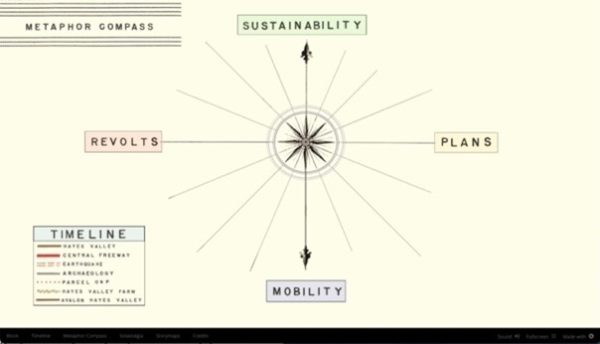
Screen grab from “Exit Zero” of the documentary’s architecture that allows multiple pathways.
Spain established its Mission in 1776 on Ohlone land where San Francisco presently exists a few days before the British settler-colonizers on the continent’s east coast declared “independence,” a nativist delusion. México ceded San Francisco, along with much of Alta California, today’s southwestern United States, in 1848. A century and a half later, San Francisco found itself as part of the Silicon Valley with tech companies transforming working-class and immigrant neighborhoods into housing for millionaires and billionaires.
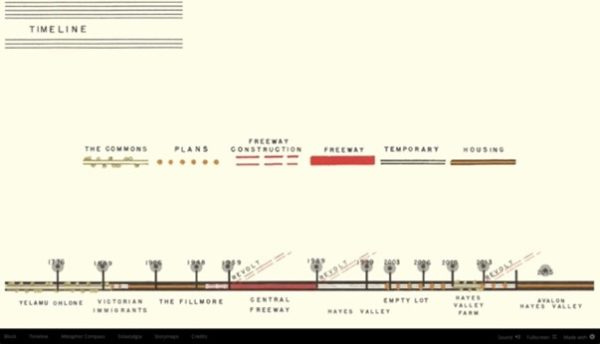
Screen grab from “Exit Zero” of the documentary’s architecture that allows multiple pathways.
“Exit Zero” develops from Landberg’s personal relationship to the San Francisco Peninsula. She is a digital artist, curator and scholar working in Santa Cruz and San Francisco. Her work focuses on ever-shifting relationships with bodies and environments across academic writing, curated exhibits and film series, documentary and essay films, experimental media, live performance, and web-based media.
Using the microcosm of a single city block, ”Exit Zero” allows users to navigate across time periods and explore connections through history using an interactive Metaphor Compass interface. Mapping the dynamics of competing narratives from precolonial Ohlone lands to privatized gentrification of today, ”Exit Zero” facilitates ways in which the past needs to be acknowledged to understand the present. Rather than conceiving history along a singular axis of time, it shifts history in a different direction to unfold in an axis of space.
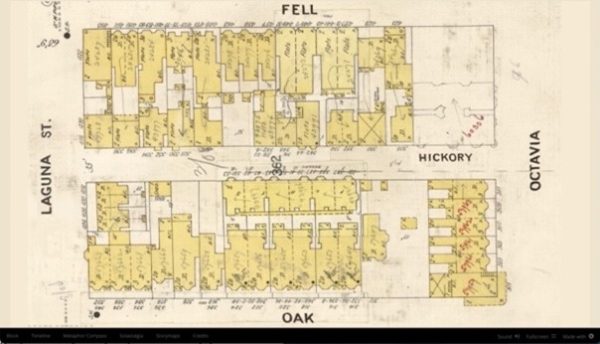
Screen grab of mapped land without acknowledgments from its residents from “Exit Zero.”
“Exit Zero” opens with video layered with voices and images of the humans whose lives overlap and sometimes even intersect in this one block. The names of streets such as Laguna and Octavia, Fell and Oak, immediately signal the block has been occupied by different peoples and identities. Before these images and voices are presented, “Exit Zero” positions itself as a land acknowledgement, a symbolic act of recognizing land grabs and ethnic cleansing of dispossession and genocide needed for Western modernity.
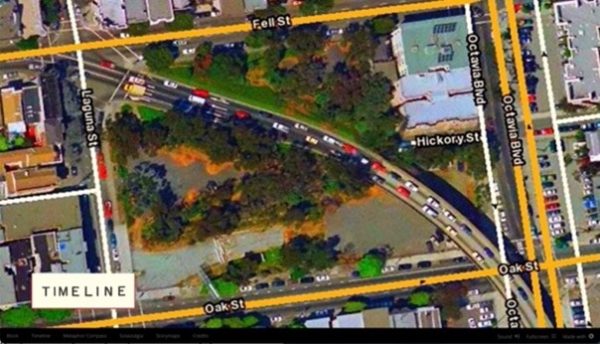
Screen grab of mapped land without acknowledgments from its residents from “Exit Zero.”
Historically, the United States ghettoized indigenous peoples onto Indian Reservations, forcing them to migrate as much as 1500 km along the Trail of Tears. Approximately 60,000 members of “Five Civilized Tribes” which included Cherokee, Chickasaw, Choctaw, Muscogee, and Seminole, were dispossessed between 1830 and 1850. Thousands died. “Exit Zero” makes an important intervention into settler-colonizer epistemologies and historiographies. “Exit Zero” not only recognizes the indigenous Yelamu Ohlone, but also subsequent inhabitants displaced by gentrification. San Francisco is a site on continuous and ongoing colonization.
The architecture of “Exit Zero” allows users to follow one of three paths through the material: Timeline, Block, and Compass. The timeline appears linear, but Landberg enhances this trajectory with different colors, thickness of lines, and symbols that convey overlapping time. The green color for Yelamu Commons reappears in the green of Avalon Hayes Valley, yet the gentrified period does not include the tree symbols of the indigenous period.
The colors follow the logic of a traffic signal. Green indicates relatively positive relationships between humans and the environment; yellow, cautionary ones; and red, negative ones. However, the story is more complex that this one vector reveals. By clicking the spaces between the historical moments, videos files open that compile archival video and images that explain debates such as the freeway revolts of 1959 and 1990.
The Metaphor Compass replaces direction with environmental terms: north with the term sustainability; east, with plans; south, with mobility; and west with revolts. By clicking on any direction, different histories are marked on the Timeline appear. Sustainability opens to five subcategories or subdirections: Permaculture, The Commons, Green Living, Housing, and, Public Transportation.
Permaculture concerns the Hayes Valley Farm, set on 2.2 acres, which might seem tiny by planetary standards but is huge by San Francisco standards. The farm reclaims land once occupied by the freeway with a greenhouse at the site of exit zero and bee hives on the site of the on-ramp. For those who participate, the land become a way to reconnect with nature while still living in the city.
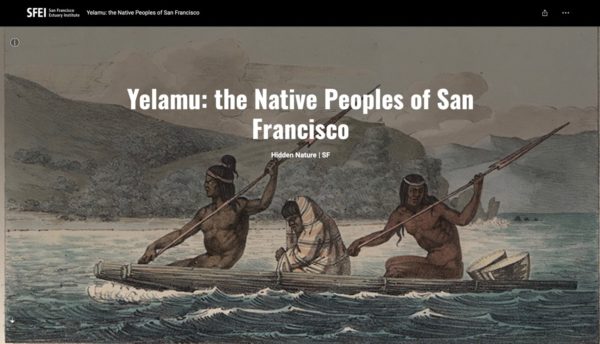
Screen grab of page from San Francisco Estuary Institute linked to “Exit Zero.”
“Exit Zero” also links via StoryMaps to external sources, such as the San Francisco Estuary Institute’s pages on the Yelamu describing the 13,500 years that Indigenous peoples lived on the land now called San Francisco. The Yelamu were forced to convert to Christianity. Most died within 4.5 years after their baptism due to “disease, overcrowding, malnourishment, and poor conditions.” By 1842, only 15 remained on the land. Today it is believed that no descendants survived.
Another part of “Exit Zero” is Solastalgia, defined as “environmental melancholia” or human stress caused by environmental changes. A short video clip of a Victorian-era building being demolished illustrates the introduction. Scholar Glenn Albrecht focuses primarily on Indigenous solastalgia. Nonindigenous forms also in experiences of gentrification in San Francisco as documented in “Exit Zero.”

Screen grab of bee hives where off-ramp one stood from “Exit Zero.”
Accounts of English Ivy and hypodermic needles as “invasive species” rendered over video layered to appear scratched and accompanied by pensive piano music. Rendered in zippy graphics and up-tempo music, these images intermingle with accounts of San Francisco’s dependency on cars as part of the ideology of the “American dream of freedom on wheels” as it coincides with U.S. military security during the Cold War.
“Exit Zero” thus augments our sense of space with layer upon layer of human experiences with, against, and for the land.
This documentary project is ultimately about the significance of land acknowledgments, symbolic acts that might contribute to the reeducation U.S. citizens after centuries of silence about these issues. “Exit Zero” works to counter the weaponization of education that rightwing political parties and politicians embrace.
It all starts with a land acknowledgement.
Dale Hudson is an associate professor at New York University Abu Dhabi. His research and teaching focus on environmentalism and on film and visual media in Southwest Asia, North Africa, and South Asia. He is co-author of “Thinking through Digital Media: Transnational Environments and Locative Places” (2015), author of “Vampires, Race, and Transnational Hollywoods” (2017), and co-editor of a double issue of “Middle East Journal of Culture and Communication” on “Film and Visual Media in the Gulf” (2021) and the book “Reorienting the Middle East: Film and Digital Media Where the Persian Gulf, Arabian Sea, and Indian Ocean Meet” (forthcoming, 2023). He programs exhibitions for the Finger Lakes Environmental Film Festival (FLEFF) and coordinates Films from the Gulf for the Middle East Studies Association (MESA) Film Festival.

